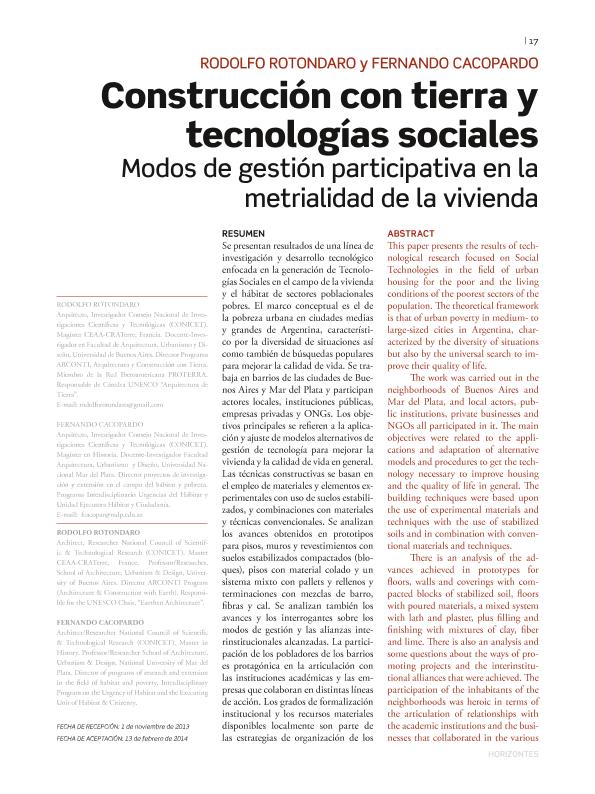Mostrar el registro sencillo del ítem
dc.contributor.author
Rotondaro, Rodolfo

dc.contributor.author
Cacopardo, Fernando Alfonso

dc.date.available
2018-01-02T21:59:11Z
dc.date.issued
2014-06
dc.identifier.citation
Cacopardo, Fernando Alfonso; Rotondaro, Rodolfo; Construcción con tierra y tecnologías sociales: modos de gestión participativa en la metrialidad de la vivienda; Horizontes para la arquitectura; Horizontes; 6-2014; 17-22
dc.identifier.issn
2007-2759
dc.identifier.uri
http://hdl.handle.net/11336/32082
dc.description.abstract
Se presentan resultados de una línea de investigación y desarrollo tecnológico enfocada en la generación de Tecnologías Sociales en el campo de la vivienda y el hábitat de sectores poblacionales pobres. El marco conceptual es el de la pobreza urbana en ciudades medias y grandes de Argentina, característico por la diversidad de situaciones así como también de búsquedas populares para mejorar la calidad de vida. Se trabaja en barrios de las ciudades de Buenos Aires y Mar del Plata y participan actores locales, instituciones públicas, empresas privadas y ONGs. Los objetivos principales se refieren a la aplicación y ajuste de modelos alternativos de gestión de tecnología para mejorar la vivienda y la calidad de vida en general. Las técnicas constructivas se basan en el empleo de materiales y elementos experimentales con uso de suelos estabilizados, y combinaciones con materiales y técnicas convencionales. Se analizan los avances obtenidos en prototipos para pisos, muros y revestimientos con suelos estabilizados compactados (bloques), pisos con material colado y un sistema mixto con pallets y rellenos y terminaciones con mezclas de barro, fibras y cal. Se analizan también los avances y los interrogantes sobre los modos de gestión y las alianzas interinstitucionales alcanzadas. La participación de los pobladores de los barrios es protagónica en la articulación con las instituciones académicas y las empresas que colaboran en distintas líneas de acción. Los grados de formalización institucional y los recursos materiales disponibles localmente son parte de las estrategias de organización de los pobladores en cada barrio. Se evalúan también las formas de transferencia y la factibilidad social y técnica de las técnicas de construcción con tierra en relación con su potencial innovador.
dc.description.abstract
This paper presents the results of technological research focused on Social Technologies in the field of urban housing for the poor and the living conditions of the poorest sectors of the population. The theoretical framework is that of urban poverty in medium- to large-sized cities in Argentina, characterized by the diversity of situations but also by the universal search to improve their quality of life. The work was carried out in the neighborhoods of Buenos Aires and Mar del Plata, and local actors, public institutions, private businesses and NGOs all participated in it. The main objectives were related to the applications and adaptation of alternative models and procedures to get the technology necessary to improve housing and the quality of life in general. The building techniques were based upon the use of experimental materials and techniques with the use of stabilized soils and in combination with conventional materials and techniques. There is an analysis of the advances achieved in prototypes for floors, walls and coverings with compacted blocks of stabilized soil, floors with poured materials, a mixed system with lath and plaster, plus filling and finishing with mixtures of clay, fiber and lime. There is also an analysis and some questions about the ways of promoting projects and the interinstitutional alliances that were achieved. The participation of the inhabitants of the neighborhoods was heroic in terms of the articulation of relationships with the academic institutions and the businesses that collaborated in the various lines of action. The degrees of the formalization of institutional bonds and the locally-available material resources are part of the organizational strategies of the inhabitants of each neighborhood. Finally, there is discussion of the feasibility of social and technical transference of earthen building techniques as it relates to its innovative influence.
dc.format
application/pdf
dc.language.iso
spa
dc.publisher
Horizontes para la arquitectura
dc.rights
info:eu-repo/semantics/openAccess
dc.rights.uri
https://creativecommons.org/licenses/by-nc-sa/2.5/ar/
dc.subject
Tecnologias Sociales
dc.subject
Desarrollo Tecnologico
dc.subject
Construccion con Tierra
dc.subject
Cogestión Interinstitucional
dc.subject.classification
Estudios Urbanos

dc.subject.classification
Geografía Económica y Social

dc.subject.classification
CIENCIAS SOCIALES

dc.title
Construcción con tierra y tecnologías sociales: modos de gestión participativa en la metrialidad de la vivienda
dc.type
info:eu-repo/semantics/article
dc.type
info:ar-repo/semantics/artículo
dc.type
info:eu-repo/semantics/publishedVersion
dc.date.updated
2017-12-29T14:20:07Z
dc.journal.pagination
17-22
dc.journal.pais
México

dc.journal.ciudad
Oaxaca de Juárez
dc.description.fil
Fil: Rotondaro, Rodolfo. Consejo Nacional de Investigaciones Científicas y Técnicas; Argentina
dc.description.fil
Fil: Cacopardo, Fernando Alfonso. Consejo Nacional de Investigaciones Científicas y Técnicas; Argentina
dc.journal.title
Horizontes
dc.relation.alternativeid
info:eu-repo/semantics/altIdentifier/url/http://horizontes18.com/revista-horizontes/
Archivos asociados
